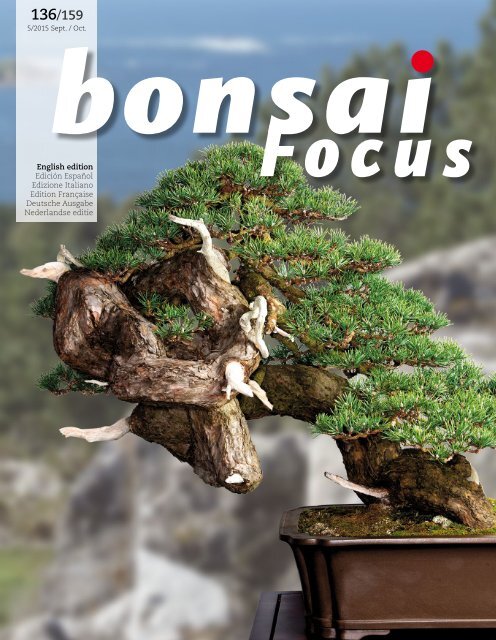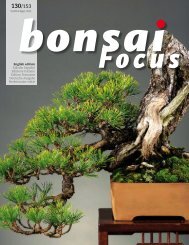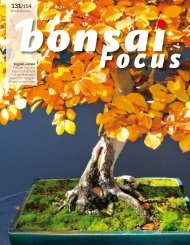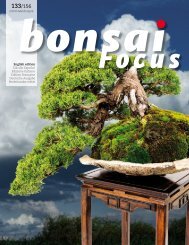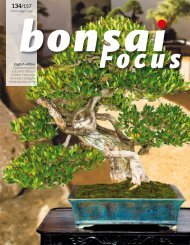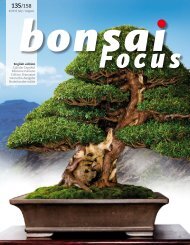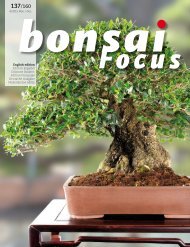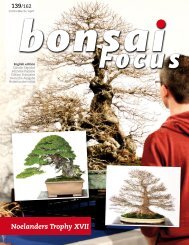Create successful ePaper yourself
Turn your PDF publications into a flip-book with our unique Google optimized e-Paper software.
136/159<br />
5/<strong>2015</strong> Sept. / Oct.<br />
English edition<br />
Edición Español<br />
Edizione Italiano<br />
Edition Française<br />
Deutsche Ausgabe<br />
Nederlandse editie
4 Bonsai Focus<br />
THIS ISSUE<br />
Our Icons<br />
Video available<br />
bonsaifocus.com<br />
Beginner<br />
Advanced<br />
On the cover<br />
Pinus sylvestris<br />
Jorge Campos, Spain.<br />
Photo: Bonsai Focus Studio<br />
Scan the code<br />
with your phone<br />
Expert<br />
68<br />
6 Report<br />
Bonsai in Cuenca by François Jeker<br />
8 News and gallery<br />
Book review and a selection of great bonsai<br />
10 Native bonsai<br />
Satisfaction kills the artist: Walter Pall on hornbeam<br />
15 Profile<br />
The bonsai passion of Viet Luan Tran<br />
15<br />
18 Kusamono<br />
Accent plants need maintenance, too<br />
21 News<br />
Insects to fertilise your bonsai? Our John Naka. Diary<br />
24 Suiseki<br />
Floating above the clouds<br />
26 Step by step with beech<br />
The smooth bark of beech makes it very appealing<br />
26
Bonsai Focus<br />
30 News<br />
Bonsai in Delft, Bonsai tonight blog, Diary<br />
32 University of wiring<br />
Learn how to use advanced wiring techniques<br />
36 Sowing the seeds<br />
The challenge this time is to create a hornbeam from scratch<br />
42 Webshop<br />
Shopping in our webshop, with special discounts for subscribers<br />
44 Masterclass with Bjorn Bjorholm<br />
Almost a 24/7 man, Bjorn works on a bulky yew<br />
54 Peter Tea's work in Japan<br />
Peter transforms a needle juniper<br />
62 Rabbits and frogs on pots<br />
Are animal caricatures the first real manga drawings in Japan?<br />
64 Report<br />
Flowers in the Water Castle by Janine Droste<br />
65 Tony's Column<br />
Tony Tickle on why it is important to visit shows<br />
44<br />
10<br />
66 Expert opinion<br />
François Jeker on Bob Buyle's spruce<br />
68 Going to show<br />
Learn from the refined art of display at the Taikan-ten in Kyoto<br />
72 A pine from Norway<br />
For a change Italian Federico Springolo works<br />
on a Scots pine from the far north<br />
78 Travel<br />
Louis Bourdeau witnesses the unique bond between Daiki Abe<br />
and his father Kenichi Abe
8 Bonsai Focus<br />
NEWS<br />
'Flip through the pages<br />
and you get a real<br />
thirst for shohin'<br />
new nuovo neu<br />
Passion for Shohin is an amazing book<br />
Shohin has gained considerable popularity; size wise it's far easier to handle<br />
and obtaining suitable material is not such a quest either. Roland Schatzer<br />
who lives near the mountains of the South Tyrol, has a real passion for these<br />
smaller sized bonsai. ‘I really couldn't find specialised books on the subject,' he<br />
explains, ‘except in Japanese and so I decided to write a book on shohin bonsai<br />
myself.' On more than 370 pages Roland shows the development of numerous<br />
varieties, Japanese and native trees. ‘It's<br />
a bulky book all about shohin: growing<br />
techniques, a varieties guide and even<br />
how to display is explained. This is a real<br />
book for those who like to grow shohin<br />
themselves and my goal was<br />
to show how<br />
to do it.' Roland<br />
adds.<br />
Pre-order now<br />
Pre-order this book on our website:<br />
www.bonsaifocus.com<br />
Retail Price: €49<br />
Bonsai Focus Subscribers' price:<br />
€ 44,10<br />
The book will be available in October <strong>2015</strong>.<br />
Roland Schatzer, 370 pages, hard cover, full colour.<br />
Available in German, Italian and English languages.<br />
Artisans Cup in Portland, USA<br />
September 25 - 27 <strong>2015</strong><br />
Venue: Portland Art museum, Portland, Oregon, USA.<br />
This completely new concept<br />
initiated by Ryan Neil and<br />
Michael Hagedorn, takes place<br />
from 25th-27th September.<br />
Ryan Neil: 'The Artisans Cup<br />
aims to showcase bonsai as a<br />
true art form. We're starting a<br />
movement to reveal the beauty<br />
of the ongoing collaboration<br />
between humans and nature that occurs during the<br />
process of training a tree.' 70 pre-selected trees will<br />
be put on display in a very special way. Judges for<br />
the cup are David Degroot (USA) Boon Manakitivipart<br />
(USA), Walter Pall (Germany) and Peter<br />
Warren (UK).<br />
Besides the show at the museum, there<br />
are numerous trips to be made, under<br />
guidance, to Ryan Neil's Mirai garden<br />
and Michael Hagedorn's collection, and<br />
Portland has much to offer as well. It has<br />
a fabulous Chinese garden and is said<br />
to have one of the best Japanese ??outside<br />
Japan. See their full programme on<br />
the website. There will be full coverage<br />
of this event by the Bonsai Focus team in<br />
one of our up-coming issues.<br />
Info: www.theartisanscup.com
Bonsai Focus<br />
NEWS<br />
9<br />
Methods of Bonsai Display<br />
By Paul Goff<br />
We were sad to hear that the author of this book, Paul<br />
Goff, passed away last November. He was known most<br />
especially for his skills with photography (the photos of<br />
Harry Tomlinson’s famous book were done by him) and<br />
his ability to teach how to display bonsai in the best<br />
possible way. You might remember our series of Paul's<br />
with the tokonoma display way back in 2002. He was a<br />
scroll painter, photographer, rock musician and bonsai<br />
artist. A very lively and creative person. The book is full<br />
of interesting stuff on how to display your trees in a<br />
very personal way. Expressions like ‘visual speed’, ‘basic<br />
flow’ and a ‘three point display’ are explained without<br />
becoming pedantic. The next step is to work with your<br />
intuition and create your own display. As Paul stated:<br />
‘The moment of pure joy is when an old tree expresses<br />
its beauty reflecting the season in a natural landscape’.<br />
All trees and scrolls in the book are by Paul Goff.<br />
Erratum:<br />
In our report of the Arco Bonsai event, page 6 of the July/August issue, we should<br />
have said the winning team with the cascade pine was from Slovakia and not<br />
from Slovenia as stated.<br />
Methods of Bonsai Display<br />
by Paul Goff<br />
Helping the bonsai artist to create<br />
harmonious display arrangements<br />
Available from SVP, PO Box 122,<br />
West Haddon, Northamptonshire, NN6 7DS, UK<br />
Price £16.95, including postage.<br />
GBP / sterling cheques only, payable to SVP.<br />
To pay by credit / debit card: telephone 0044 (0)1788 510442<br />
Payment by PayPal quote: vmct@bonpres.freeserve.co.uk<br />
Limited edition hand-painted porcelain pots<br />
Bonsai Focus presents limited edition pots — 25 pots each of<br />
five different scenes. These hand-painted porcelain pots with<br />
landscape scenes are stamped with the Bonsai Focus logo. Each<br />
pot comes in a gift box as shown. Size: 11 x 8 x 4cm / 4¼ x 3¼ x<br />
1½". Order at: www.bonsaifocus.com<br />
For Bonsai Focus subscribers:<br />
€ 59,95<br />
Island scenery<br />
House on the rocks<br />
Chinese poem<br />
The pot comes<br />
with a gift box<br />
Mountain scenery<br />
Hut by the sea
36 Bonsai Focus<br />
TECHNIQUE<br />
Sowing the seeds<br />
Hornbeam: the challenge is to create a finished tree starting from zero<br />
Illustrations: Kyosuke Gun Text: Kinbon magazine, Japan<br />
One of the ultimate challenges facing us is to create a tree from seed. In our previous issue we showed how to grow<br />
a pine from seed. We continue now with how to grow a hornbeam (Carpinus betulus). With the help of illustrations we<br />
aim to guide you through the process<br />
1st - 2nd year<br />
The large buds will<br />
be next year's flowers<br />
October - November<br />
Seed collection<br />
3rd year<br />
Cut<br />
Transplanting: early<br />
spring<br />
A large flower head at the end<br />
of the branch<br />
After planting<br />
Remove the strong<br />
tap root and plant in<br />
individual pots<br />
At the base of the 'scales' in<br />
the flower you will find the<br />
seeds<br />
Soil example: Akadama<br />
7, Kiryu 3, plus 5%<br />
charcoal<br />
Seeds<br />
Sowing the seeds<br />
Top soil approximately twice the<br />
depth of seeds<br />
Akadama main soil<br />
Carpinus betulus by Roland<br />
Schatzer<br />
Large particle soil<br />
Second year seedling:<br />
Approximately 10 to<br />
12 cm / 4 to 4¾"<br />
Wiring the trunk:<br />
Summer time. Once into<br />
the third year, growth<br />
speeds up noticeably.<br />
Wire the trunk to create<br />
movement<br />
Secondary branches<br />
start to develop<br />
Growth is slow for the first<br />
two years<br />
Lower branches can be utilised to<br />
increase girth, if required<br />
Fertilise twice in<br />
spring, three times in<br />
autumn. In summer<br />
liquid fertiliser can be<br />
given<br />
During growing season<br />
about 5 to 6 cm /<br />
2 to 2¼" of growth
42<br />
WEBSHOP<br />
Top quality bonsai tools for competive prices<br />
Expert 12-piece stainless steel tool<br />
set based<br />
Special offer<br />
Stainless steel wire cutter 120mm<br />
€ 15,-*<br />
*Price for subscribers;<br />
normal price: € 22,-<br />
€ 294,95<br />
Concave cutter 210mm<br />
Root hook 210mm<br />
Jin pliers 230 mm<br />
€ 34,95<br />
€ 12,95<br />
€ 30,-<br />
Exclusively for subscribers: 10% discount in our webshop<br />
Pyracantha<br />
Ilex, serrata<br />
€ 250,-<br />
Chaenomeles<br />
sinensis<br />
€ 265,-<br />
Iles serrata<br />
€ 139,50<br />
€ 145,-<br />
Pinus penthaphylla<br />
Chaenomeles sinensis<br />
€ 225,- € 155,-<br />
'Hinoki'<br />
Chamaecyparis<br />
€ 179,-
Bonsai Focus<br />
Source of inspiration<br />
WWW.<strong>BONSAI</strong><strong>FOCUS</strong>.COM<br />
43<br />
Binder<br />
Our new binder is now available and will fit the<br />
newly re-designed format of your magazine.<br />
As you can see, it is quite similar to the previous<br />
binder, but is now slightly larger.<br />
To get your new binder and to buy any of the<br />
featured items on these pages go to our website:<br />
www.bonsaifocus.com<br />
Rhododendron indicum,<br />
Hakurin<br />
Acer burgerianum<br />
Pinus parviflora<br />
€ 75,-<br />
€ 595,-<br />
€ 395,-<br />
Pyracantha<br />
Gardenia Jasminoides<br />
Acer palmatum<br />
€ 71,50<br />
€ 155,-<br />
€ 202,50<br />
Pinus parviflora<br />
€ 3300<br />
WWW.<strong>BONSAI</strong><strong>FOCUS</strong>.COM
Bonsai Focus<br />
TRAVEL<br />
79<br />
The tree before any work is done, it has interesting<br />
trunk movement and a fine nebari<br />
Daiki examines the options carefully; from which side<br />
do all elements come together?<br />
This is the choice, made because of the more slanting<br />
movement in the trunk<br />
The view of the top branches before wiring<br />
The drawing shows how the back bone<br />
wire runs<br />
A crossroad of wires<br />
Finger fast, Daiki and Kenichi work<br />
together, their wire is applied almost<br />
automatically. But if you take a close look<br />
you will notice criss-crossing wires. This<br />
is done deliberately as an extra protection<br />
from damage when thick branches are<br />
bent. The back bone wire functions as a<br />
kind of raffia.<br />
Daiki wires the finer branches<br />
A loop around the branch<br />
anchors the wire<br />
Some branches have protective tape wrapped<br />
around them<br />
Next comes the preparation of the nebari or root base. A layer of soil is<br />
removed to decide which surface roots should be removed or corrected.<br />
A fine developed nebari is essential for the whole design. Surface roots<br />
that are too thick can cause trouble in future, so need to be removed or<br />
partially cut back to allow the fine roots to take over.<br />
The selection of branches and wiring is actually the most important<br />
part of the shaping process and therefore maybe the most difficult. It is<br />
not only about the tree's future, but also to be aware that no backward<br />
step is possible. A poorly placed wire can be corrected, a branch that is<br />
Daiki at work<br />
Note how the<br />
tree's roots are<br />
covered with a<br />
cloth, rather like<br />
a barber does!
80 Travel<br />
Bonsai Focus<br />
not too thick can be folded, but a branch<br />
cut is gone forever. This task requires<br />
great experience and a strong sense of<br />
the aesthetics. Although Daïki did most of<br />
the work, he modestly told me that really<br />
only his father is able to make a selection<br />
on any kind of araki.<br />
Grafting tape<br />
After this, the wiring work can begin.<br />
Before starting, Daïki informs me that you<br />
cannot wire a red pine like a white pine<br />
because its branches are far more fragile.<br />
They do not allow such strong bendings<br />
and often require some protection or<br />
guy wires. Daïki uses some grafting tape<br />
Kenichi Abe joined his son. They are as<br />
essential to one another as they are hard<br />
to assess, especially for me, the humble<br />
witness to their work. As I watched Mr<br />
Abe and his son changing the position of<br />
a branch, or viewing this tree silently, the<br />
very close cooperation between father<br />
and son was intense. Maybe something<br />
beyond the relationship between a father<br />
and a son, or Master and his apprentice.<br />
It is undoubtedly what the Japanese call<br />
'ishin-den-shin', a silent communication<br />
from heart to heart.<br />
Daiki wiring the upper part of the tree<br />
to protect the thin branches. For larger<br />
branches, the Abe’s very often use the<br />
technique of back bone wiring.<br />
The fragility of the red pine branches can<br />
be explained by the fact that they grow in<br />
the low mountain areas. They therefore<br />
have to support less heavy snow falls<br />
than the white pine whose flexibility is a<br />
result of adapting to the weight of snow<br />
in the high mountains. Observing trees'<br />
natural habitat can help us to understand<br />
some of their characteristics.<br />
For the final touches or any adjustments,<br />
Kenichi Abe<br />
makes some fine<br />
corrections<br />
The result so far, it will need more years to become a refined bonsai<br />
The famous tool<br />
This tool, specially for making jin,<br />
was designed by Kurakichi Abe<br />
(father of Kenichi Abe). A kind of<br />
hybrid between concave cutters<br />
and branch splitters it removes<br />
bark easily. It bites into the wood,<br />
you turn it and then the bark is<br />
stripped and you can shape the<br />
jin by repeatedly cutting into the<br />
wood. It needs a little practise<br />
though.
Bonsai Focus<br />
NEXT ISSUE<br />
81<br />
Issue 137 November / December<br />
MAINT<strong>EN</strong>ANCE<br />
Clipping, wiring, branch selection, pinching — all are explained<br />
while working on one of our favourite species, the beech.<br />
WORKSHOP<br />
A native grown pine from Spain gives great results in the hands<br />
of French artist JP Hoareau.<br />
DAVID B<strong>EN</strong>AV<strong>EN</strong>TE<br />
For David it was love at first sight when he discovered this huge<br />
yew during one of his many trips to Japan.<br />
HOTSUMI TERAKAWA<br />
Now living in Japan, Hotsumi applies his refined skills to a<br />
juniper.
For the complete<br />
Subscribe now!!<br />
You are just<br />
one click away!!


